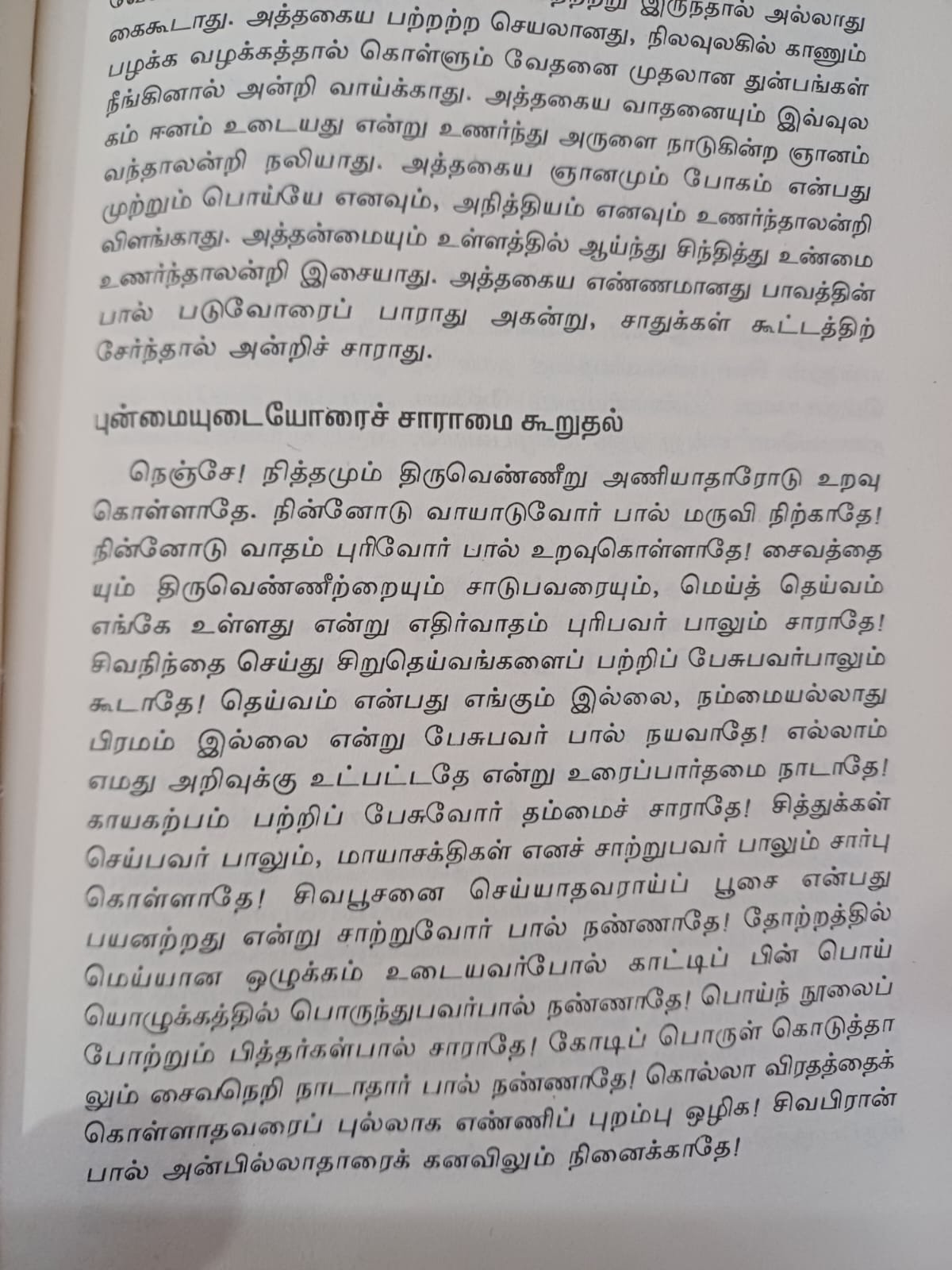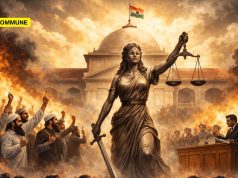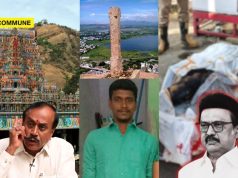
The dissemination of false information throughout history is not a novel tactic for the ruling Dravida Munnetra Kazhagam government in Tamil Nadu. Even in the contemporary era, when confronted, they persist in employing this strategy, particularly targeting Hindu Dharma, despite proclaiming themselves as secularists and atheists on numerous occasions. Presently, the narrative surrounding the portrayal of Ramalinga Adigalar, commonly known as Vallalar, a staunch believer in Shaivism who composed many songs dedicated to Lord Murugan and Shiva, has sparked controversy. The Hindu Religious & Charitable Endowment Department’s depiction of Vallalar without “Vibuthi” or Thiruneer or sacred ash has stirred a significant uproar on social media.
வள்ளலார் சர்வதேச மையம் திட்டமிட்டபடி அமைக்கப்படுவதால் ஜோதி தரிசனம் காண்பவர்களுக்கு நிச்சயம்
எவ்விதமான இடையூறும் இருக்காது.
மாண்புமிகு இந்து சமய அறநிலையத்துறை அமைச்சர் திரு. @PKSekarbabu அவர்கள் தகவல். @TNDIPRNEWS #tnhrce #MKStalin #pksekarbabu#CMMKSTALIN #TNDIPR pic.twitter.com/1v2VBXsq2g— TN HRCE (@tnhrcedept) February 24, 2024
Netizens quoted his Nenjararivuruthal poem where he advises his own mind to not be associated with those who don’t wear Neeru (sacred ash) everyday. They also likened it to the instance of secularising Thiruvalluvar.
Ramalinga Swamigal aka Vallalar, a saint who was also a great Shiva devotee is portrayed as "secular" with a Paazh Netri by TN HRCE.
In his Nenjararivuruthal poem, Vallalar advises his own mind to not be associated with those who don't wear Neeru (sacred ash) everyday.
Irony is… https://t.co/q2oOF1X7c5 pic.twitter.com/3qEVkVTQcK
— Tamil Labs 2.0 (@labstamil) February 24, 2024
Vallalar’s Life – A Divine Journey Of Enlightenment And Compassion
Vallalar, also known as Ramalinga Adigalar, was a 19th-century Tamil saint and philosopher who played a significant role in the Bhakti movement in South India. Born on 5 October 1823, in Marudur, Chidambaram, Vallalar dedicated his life to spiritual pursuits and the service of humanity. He was a devoted follower of Lord Murugan and Lord Shiva.
Ramalingam’s spiritual journey began at a young age, marked by divine experiences that shaped his profound connection with the divine. At just five months old, his joyous reaction during a temple ritual at Chidambaram Natarājar Temple was perceived by him as a deep spiritual encounter, describing the moment as the revelation of the Divine Light of Grace (Arut Perum Jodhi). Following his father’s death in 1824, Ramalingam and his mother moved to Chennai, where he displayed disinterest in formal education but developed a deep affinity for the nearby Kandha Kottam Kandha Swāmi Temple. Despite facing disciplinary measures from his elder brother, Sabhapati, for neglecting his studies, Ramalingam’s spiritual inclinations grew stronger. In a remarkable experience, Ramalingam witnessed a vision of Lord Muruga, describing the divine manifestation with the words, “Six divine faces adorned with beauty and twelve illustrious shoulders.”
His intellectual and spiritual growth accelerated, and at the age of thirteen, he renounced the worldly life. Despite being forced into marriage, legends recount his disinterest in material pursuits, with his focus on spiritual practices and devotion. His later life was characterized by a reputed “physical transformation,” as he seemingly transcended ordinary bodily needs.
Vallalar is renowned for his extensive writings, including philosophical poems and devotional hymns. His most famous work is the “Tiruvarutpa,” a collection of poems expressing his deep spiritual insights and devotion to the divine. Additionally, he crafted the Veeraraghva Panchakam, a poetic composition dedicated to Veeraraghava Perumal situated in Tiruvallur. Among his other notable works is the Manumurai Kanda Vāsagam, providing insights into the life of Manu Needhi Cholan, and the Jeeva Karunya Ozhukkam, which underscores compassion for all living beings and advocates for a plant-based diet.
Vallalar imparted various life principles and a philosophy of life to people. One of Vallalar’s notable contributions was the establishment of the “Samarasa Suddha Sanmarga Sathiya Sangam,” an organization promoting religious tolerance, equality, and humanitarian values. He advocated for the eradication of caste distinctions and encouraged people to see the divine in every being. His Famous sayings “Whenever I saw a withered crop, I withered..!” and advocated vegetarianism and providing free food to the needy.
His teachings and contributions continue to inspire followers, and his memorial, known as the Vallalar’s Samadhi, in Vadalur, Tamil Nadu, serves as a place of pilgrimage for those seeking spiritual solace.
The revered Tamil saint, known for his profound devotion, has faced disrespect as the HR&CE department led by DMK intentionally erased the sacred ash from his forehead. Even the authentic photographs displayed at his mutt depict him adorned with full vibuthi, emanating a divine and radiant aura.
https://twitter.com/StardustRooba/status/1761488072288637305
In films inspired by the verses and songs of Vallalar, actors often portray characters adorned with sacred ash (Vibuthi) on their foreheads. As an illustration, consider a scene from the movie “Kaithi” where the protagonist engages in the recitation of Vallalar’s Thiruvarutpa, chanting praises to Lord Shiva.
“Even if a child forgets its mother
Even if the mother forgets the child
Even if the soul forgets the body
Even if the body forgets the soul
Even if the mind forgets whatever is learnt
Even if the eyes forget to blink
Never shall I forget ever the divine Nama Shivaya which blazes from the heart of the Tapaswis (those in lofty penance).” ( திருஅருட்பா – பெற்ற தாய் தனை மக மறந்தாலும்)
The prayer that Karthi is saying in the blockbuster film "Kaithi" is an outpouring of devotion on Lord Shiva, written by Vallalaar.
Vallalaar said that even impossible events like mother forgetting her child, eyes forgetting to blink may happen, but he will never ever forget… pic.twitter.com/7Ogvb74WEi
— Tamil Labs 2.0 (@labstamil) February 24, 2024
In the film “Monster,” SJ Suryah portrays the character Anjanam Azhagiya Pillai, who has been a devout follower of Vallalar since his early years. This deep-rooted connection with spirituality has instilled in him a profound respect for all living beings. Below are the representations from the movie.
SJ Suryah plays the role of a Vallalaar devotee in the film "Monster" who strives to live without hurting any living being – be it an ant or a rat!
Both Anjanam Azhagiya Pillai's guru and Vallalar Ramalingam Swamigal can be seen wearing the Vibhoothi (sacred ash) throughout the… pic.twitter.com/KjOQhuveVV
— Tamil Labs 2.0 (@labstamil) February 24, 2024
In the poem “Nenjararivuruthal” (Guidance to the Heart), Vallalar counsels his own mind states, “Oh heart, refrain from forming connections with those who do not adorn themselves regularly with Thiruveneeru (Sacred Ash). Don’t be mesmerized by those who talk to you. Avoid relationships with those who argue with you. Refrain from associating with who criticize Shaivism, Thiruveneeru, and those who engage in debates questioning the existence of the true God.”
(Credits: Tamil Labs 2.0)
Devotees in many households have revered images of this saint, depicting him with divine grace and a sacred vibuthi/thiruneer/ash mark on his forehead. However, there is widespread speculation on social media regarding a narrative promoted by the HR&CE department. This narrative draws parallels with their alleged actions against Thiruvalluvar, stripping him of his Hindu identity. Now, concerns are raised that the DMK government is poised to target Vallalar Ramalingarnar in a similar manner.
An old pic of Vallalar with vibhooti smeared in his forehead. What happened to that in the pic you posted @tnhrcedept .
Don't you have shame? https://t.co/nzfiq5EpjI pic.twitter.com/2GrNTvxgMO— Living Temples Of Bharat (@Saigeet36566874) February 24, 2024
Secularizing Attempt On Thiruvalluvar
Thiruvalluvar, a revered Tamil saint and poet, has similarly faced ongoing attempts to secularize and obscure his original Hindu identity. Political agendas particularly DMK have promoted incomplete artistic representations in the guise of secularism. However, a closer examination of the words used in his couplets reveals his deep-rooted connection to Hinduism. Thiruvalluvar’s true identity has been intentionally concealed, with political parties fostering distorted depictions to distance him from Hindu traditions.
There are even claims from within a political party that the construction of the sizable Thiruvalluvar statue in Kaniyakumari was a deliberate attempt to overshadow the Swami Vivekananda Memorial, a significant symbol of Santana Dharma. Thiruvalluvar’s genuine identity came to light through a 14th-century statue discovered in Mylapore, exposing various distortions in modern representations, such as covering the yagnopaveetham (sacred thread) with cloth, replacing chin-mudra (upadesa mudra) with an instrument for writing on palm leaves, modifying the pleating of his hair, and elongating his ear holes due to the persistent wearing of earrings.
Subscribe to our channels on Telegram, WhatsApp, and Instagram and get the best stories of the day delivered to you personally.





